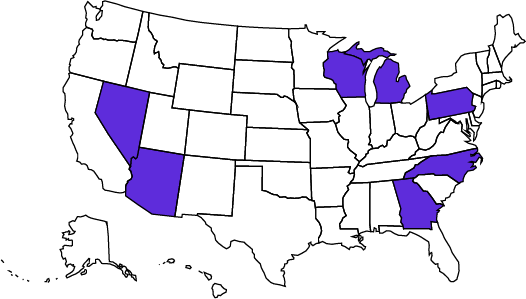Introduction
Swing states are crucial in U.S. elections because they have the potential to sway results. Unlike states that reliably support one party, swing states are unpredictable, becoming vital battlegrounds in presidential races. Their shifting voter preferences mean candidates and the media focus heavily on them. Understanding the dynamics of swing states, their voting history, and why they’re called battlegrounds sheds light on their significant political relevance.

[Swing States] Image courtesy of Anonymous Giraffe
Definition of Swing States
Swing or battleground states are relevant in U.S. elections because they don’t consistently back one party. These states show unpredictable voting patterns and could swing toward either the Democratic or Republican party. Unlike partisan strongholds, swing states are targeted during presidential campaigns since their unpredictable outcomes can decide the race.
The term “swing state” reflects voters’ shifting support for different parties in elections. For example, while California reliably votes Democratic and Texas leans Republican, states like Pennsylvania and North Carolina regularly switch affiliations. Due to this unpredictability, swing states become central to campaign efforts, including rallies, ads, and political debates.
Historical Context and Evolution
The idea of swing states has changed over time due to demographic shifts, economic changes, and changes within the political parties. Historically, many states have shifted politically because of factors like population growth, migration, and evolving industries.
In earlier U.S. elections, different states held the title of swing states. For instance, New York was once key, with its many electoral votes and variable results. However, as demographics have changed, states like Pennsylvania, North Carolina, and Georgia have recently become more critical.
The evolution of swing states is closely tied to political climates and nationwide societal changes. Shifts in political ideologies, the growth of urban versus rural areas, and economic changes all play a part. For example, increasing diversity and urbanization in states like Nevada and Arizona have made them more competitive in recent presidential races, reflecting more significant national trends.
Electoral College System
Due to the Electoral College system, swing states play a crucial role in U.S. presidential elections. Each state receives electoral votes based on its Congressional representation—each state has two senators and the number of House representatives based on their number of Congressional Districts (CD)—giving larger states more electoral votes.
To win the presidency, a candidate must secure a majority of electoral votes, at least 270 out of 538. Swing states are important because they often hold many electoral votes that can sway the election results. For instance, Pennsylvania’s 19 electoral votes make it a key target.
Most states use a winner-takes-all approach, awarding all their electoral votes to the candidate who wins the popular vote in that state. This makes swing states pivotal battlegrounds, as winning them can significantly help a candidate reach the 270-vote mark needed to become president.
Impact on Presidential Elections
Swing states are key in deciding presidential elections. Winning often hinges on a candidate’s success in these unpredictable states. Securing swing states can offset losses in heavily partisan areas, providing essential electoral votes for a majority.
Take the 2000 election between George W. Bush and Al Gore, for example. That race was famously decided by a razor-thin margin in Florida, illustrating how significant one state can be in determining election outcomes.
In recent times, states like Michigan and Pennsylvania have been vital for candidates seeking the presidency. Since 1964, no one has won without Ohio until President Joe Biden won the presidency without Ohio in 2020. President Biden’s win broke the record for predicting a winner in the bellwether state.
Importance in Campaign Strategies
Swing states play a vital role in shaping campaign strategies for presidential candidates. Recognizing their importance, candidates devote substantial time, resources, and effort to these areas, focusing on local issues, tailored messages, and significant financial investments in ads and rallies.
Candidates analyze voter demographics and trends in swing states to customize their outreach. For example, they may address specific economic concerns in the industrial heartland, aka the Rust Belt states, such as manufacturing job losses, or focus on immigration policies in states like Arizona and Florida.
Campaign visits to swing states far exceed those to non-competitive states, as face-to-face interactions can influence undecided voters. Campaign stops often concentrate on urban centers while addressing rural areas, which is pivotal in tight races.
The digital age has boosted the importance of targeted ads in swing states. Campaigns use data analytics to identify voter preferences and tailor social media and digital ads to resonate with specific state and local issues.
In summary, swing states have an outsized influence on U.S. presidential elections due to their unpredictability and the strategic emphasis placed on them through the Electoral College system. Understanding these pivotal battlegrounds’ unique aspects and importance can help explain why they are given so much attention and significance during election cycles. The dynamic nature of swing states ensures they remain a compelling factor in American politics, underscoring the vibrant democracy of the United States.
Characteristics of Swing States

[Diversity] Image Courtesy of Pixabay
Swing states, also known as battleground states, play a pivotal role in determining the outcome of U.S. presidential elections. These states do not consistently vote for one political party, making them highly competitive. Understanding the characteristics of swing states provides insight into why they hold such significant political clout.
Demographic Diversity
One of the defining characteristics of swing states is their demographic diversity. These states often have more varied populations than states that strongly lean toward a single political party. This diversity encompasses race, age, education, and urban versus rural living.
Racial and Ethnic Diversity
Swing states often have significant minority populations. For instance, states like Arizona and Nevada have large Latino populations, while North Carolina and Georgia have substantial African American communities. The voting preferences and turnout rates of these groups can significantly sway the election results.
Age and Generational Mix
A varied age distribution is also typical in swing states. Some geographies experience a significant influx of younger, college-educated voters who may lean more liberal, while others have older populations who are more likely to be conservative. These generational differences contribute to unpredictable voter behavior.
Educational Attainment
Education levels in swing states vary widely. They may have large populations of both college-educated professionals and blue-collar workers, which can influence voting tendencies. College towns like Pennsylvania differ politically from industrial areas in the same state.
Economic Factors
Financial conditions within swing states are another key characteristic contributing to their unpredictable voting patterns. These conditions impact residents’ priorities and choices during elections and can include:
Industry Composition
Many swing states have diverse economies that include both traditional manufacturing sectors and emerging industries. States like Michigan, Wisconsin, and Pennsylvania have histories rooted in manufacturing but are also witnessing growth in technology and service industries. As economies evolve, voter priorities can shift, affecting party preferences.
Income Levels and Economic Disparities
Socio-economic diversity within swing states often leads to distinct political concerns. Affluent urban areas may prioritize issues like business incentives and tax policies, and less prosperous regions may prioritize healthcare access, employment opportunities, and education funding. These differing priorities can sway voters in varying directions.
Employment Rates and Economic Growth
Swing states’ economic health often influences elections. That isn’t to say it isn’t a factor in all fifty states. States facing financial challenges, especially those reliant on industries impacted by global competition or technological changes, may see voters increasingly focused on candidates’ economic policies and solutions.
Political History
The political history of swing states adds another layer of complexity to their role in elections. Their past voting behaviors and party affiliations contribute to their status as battlegrounds in the electoral process.
Historical Voting Patterns
Swing states have a history of fluctuating between supporting Democratic and Republican candidates. For example, Ohio has voted for both parties throughout its history and is known as a bellwether state. This unpredictability often attracts political campaigns that expend significant resources on swaying their electorate.
Regional Identity and Partisan Shifts
Changes in regional identity and demographics over time can lead to shifts in political alignment. States like Virginia, traditionally Republican, have seen a growing trend of Democratic successes due to an increase in urbanization and demographic changes. The residents in Virginia now include people from other places like India and Korea who traditionally vote for Democrats. Understanding these shifts is crucial for predicting future voter behavior.
Local Political Dynamics
Swing states can have complex political dynamics shaped by local governance and influential political figures. State-specific issues, such as ballot initiatives or contentious local policies, might mobilize voters differently depending on their immediate impacts, further contributing to the state’s swing status.
In summary
Swing states are characterized by their demographic diversity, economic factors, and political history, making them unpredictable yet significantly important in U.S. elections. Their unique blend of races, financial priorities, and historical voting patterns creates a dynamic landscape that requires candidates to meticulously tailor their strategies to win support. Understanding these characteristics clarifies why they are campaign focal points and how they can tip the scales.
Conclusion
Swing states play an essential role in determining the outcome of U.S. elections. Their unpredictable voting patterns require candidates to focus resources on winning these key areas. The significance of these states extends beyond individual elections because they inspire robust political debates and can influence national policies.
- Swing states often reflect the country’s evolving political, economic, and social dynamics.
- They serve as a population of diverse voter demographics and ideological shifts.
Understanding swing states provides insight into the broader electoral landscape, emphasizing their continuous impact on shaping the nation’s political future.
Author’s Note
I have drawn attention to the word unpredictable because it is my opinion these states would not be so unpredictable if they were more tuned into the political world through doing their own research instead of listening to the



